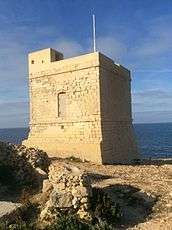Triq il-Wiesgħa Tower
| Triq il-Wiesgħa Tower | |
|---|---|
| Torri ta' Triq il-Wiesgħa | |
| Part of the De Redin towers | |
| Żabbar, Malta | |
|
Triq il-Wiesgħa Tower | |
| Coordinates | 35°52′40.7″N 14°33′51.4″E / 35.877972°N 14.564278°E |
| Type | Coastal watchtower |
| Site information | |
| Owner | Government of Malta |
| Controlled by | Fondazzjoni Wirt Artna |
| Open to the public | No |
| Condition | Intact |
| Site history | |
| Built | 1659 |
| Built by | Order of Saint John |
| Materials | Limestone |
Triq il-Wiesgħa Tower (Maltese: Torri ta' Triq il-Wiesgħa), originally known as Torre della Giddida[1] and also called Mwejġel Tower (Maltese: Torri ta' Mwejġel or Torri tal-Imwiegħel),[2] is a small watchtower near Żabbar, Malta. It was built in 1659 as the ninth of the De Redin towers. The tower suffered extensive damage in the 20th century, with parts of the structure being demolished, but it was restored between 2008 and 2009 and it is now in good condition.
History
Triq il-Wiesgħa Tower was built in 1659 on the shore east of the Grand Harbour.[3] Its name means "Wide Street", because of the wide stretch of coastline it had to defend.[4] It follows the standard design of the De Redin towers, having a square plan with two floors and a turret on the roof. Triq il-Wiesgħa Tower had Santa Maria delle Grazie Tower in its line of sight to the west, and Żonqor Tower to the east, but these no longer exist as they were both demolished by the British military.
In the 1870s, Fort Leonardo was built about 350 m (1,150 ft) away from the tower. The fort was on high ground and Triq il-Wiesgħa Tower did not fall in its line of fire. Had the tower fell within the line of fire, it would have most probably been demolished, as was done in other cases such as Delimara Tower and Bengħisa Tower, which were demolished to clear the lines of fire of Fort Delimara and Fort Benghisa respectively.

By the early 20th century, the rear part of the tower had collapsed and the tower was in ruins, but it was restored in the 1930s. The tower's parapet and turret were removed in World War II, and pillboxes were built in its vicinity. The tower was further damaged when an aircraft crashed nearby.[5]
Present day


After the war, the tower fell again into a state of disrepair, with part of its foundations having collapsed. In 2004, it was handed to Fondazzjoni Wirt Artna. Restoration began four years later in September 2008,[6] and was complete by March 2009. During the restoration, the features removed during World War II were also rebuilt.[7]
References
- ↑ Ġrajjet Malta - It-Tielet Ktieb (in Maltese) (4 ed.). Sliema: Department of Education. 2006. p. 81.
- ↑ "Il-Fortifikazzjonijiet fi zmien l-Ordni". vivait36.weebly.com (in Maltese). Retrieved 28 June 2016.
- ↑ Zammit, Vincent (1992). Il-Gran Mastri – Ġabra ta' Tagħrif dwar l-Istorja ta' Malta fi Żmienhom – L-Ewwel Volum 1530-1680 (in Maltese). Valletta: Valletta Publishing & Promotion Co. Ltd. p. 236.
- ↑ "Towns and Villages in Malta and Gozo". Malta-The George Cross Island. Archived from the original on 31 May 2015.
- ↑ "Commencement of Works - Xghajra Tower". Vaults Co. Ltd. October 2008. Archived from the original on 31 May 2015.
- ↑ Baldacchino, Lisa Gwen (20 September 2008). "17th century tower in Xgħajra being restored". Times of Malta. Archived from the original on 1 June 2015.
- ↑ "Completion of Works – Xghajra Tower". Vaults Co. Ltd. March 2009. Archived from the original on 31 May 2015.
External links
| Wikimedia Commons has media related to Triq il-Wiesgħa Tower. |
